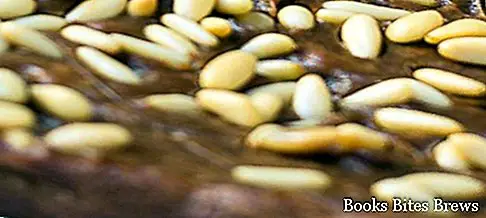How to make the chestnut cake, chestnut flour recipe with raisins, pine nuts and orange zest, to be baked in the oven, recommended combinations and historical origins.
Ingredients for 6 portions
- 6 walnuts
- Rosemary
- 2 tablespoons of sugar
- Little orange peel
- Sweet chestnut flour gr. 400
- Raisins gr. 100
- Pine nuts gr. 50 shelled
- Olive oil
- Little salt
Preparation of the cake chestnut raisin and pine nuts
Sift the sweet flour and put it in a bowl. Add the sugar, a pinch of salt, a teaspoon of chopped zest and half a liter of water. Stir well to obtain a liquid and lump-free batter.
Recommended readings- San Giuseppe pancakes with raisins
- Simple and fast classic apple pie recipe
- Charlotte with dark chocolate mousse
- Raspberry jam tart with almonds, hazelnuts and pine nuts
- Cake with chestnut flour, pine nuts and raisins
Add a couple of tablespoons of oil and let stand for about an hour. Grease a pan and pour the batter into it (it should be a little less than a finger high, not more). Sprinkle the surface with rosemary leaves, soaked raisins, pine nuts and shelled and chopped walnuts. Sprinkle with 2 tablespoons of oil and bake in a hot oven for about 40 minutes.
Traditional chestnut cake
In the autumn season, castagnaccio is certainly one of the recipes most commonly used in the kitchen as a dessert. The result is that of a cake that has chestnut flour as its main ingredient and is typical of the localities located in various regions, especially Tuscany, Liguria, Emilia and Piedmont.
A chestnut cake is cooked in the oven and, in addition to chestnut flour, the dough contains water, extra virgin olive oil, pine nuts and raisins. In some areas other elements are introduced such as variants including rosemary, orange peel, fennel seeds and dried fruit.
The castagnaccio is excellent if paired with cow or sheep ricotta, watering everything eventually with good vin santo.
Castagnaccio was originally considered a poor dish as in the past, especially in the areas of the Tuscan Apennines, it was widespread as chestnuts were the basis for the nutrition of peasants of the time. The inventor was Pilade from Lucca in the sixteenth century.




